Classic Filipino Style Family Recipe Collection
Discover the joys of Filipino style recipes for the whole family with this recipe collection. All of the ingredients are easy to find or use the recommended substitutes and alternatives. Enjoy!
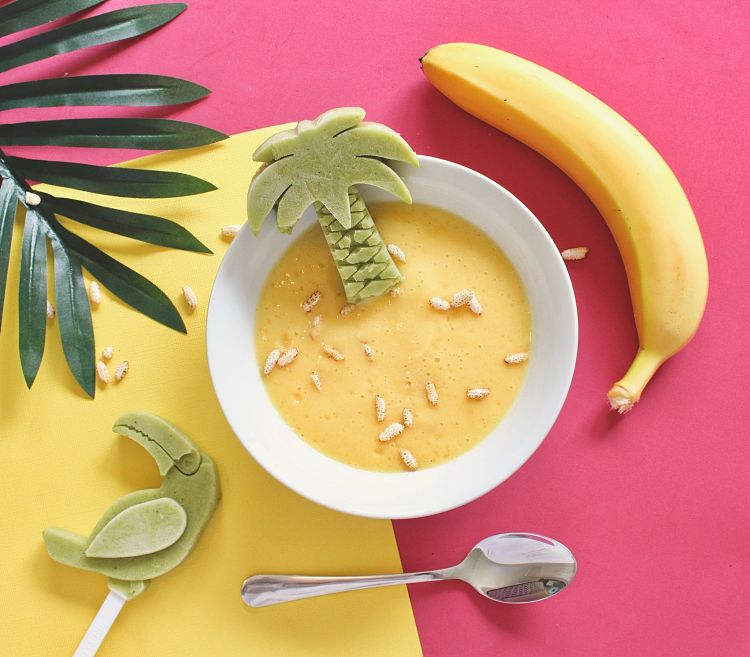
Classic Seafood Soup Recipe (Sinigang)
Ingredients
- Fish sauce to taste
- 4 large tomatoes, quartered
- 2 large shallots, roughly diced
- 1 bunch morning glory, thick stems removed
- 3 tablespoons tamarind extract or equivalent
- 2-3 fresh bird’s eye chillies, split in the middle
- 1 litre (1 quart) good quality fish stock (homemade preferred)
- 500 g (16 oz) firm white fish fillets, cut into 4 cm (2 inch) chunks
- 500 g (16 oz) large prawns, shelled and deveined but head and tail kept on
- 250 g (8oz) long beans (snake beans) or green beans, trimmed and sliced into into short lengths
Method
Transfer the fish stock into a Dutch oven or large heavy-based saucepan or frying pan. Add the tamarind paste or powder and the chillies, and bring to a boil over moderate heat. Then, add the tomatoes and shallots. Turn down the heat to low, and simmer the pot for 4-5 minutes until the shallots become translucent. Place the beans in a spider strainer cook in the simmering broth for about 4-5 minutes, until the beans just start to become tender and remain vibrant green in color. Transfer the beans to a plate and set aside.
Next place the fish in the strainer cook in the simmering broth for about 4-5 minutes until just barely cooked. Transfer the fish to a plate and set aside. Then, cook the prawns in a similar way and then remove and set aside. Lastly, cook the morning glory in the simmering broth for only about 60-90 seconds, remove and set set aside. Divide the fish, prawns, beans and herbs between 4 serving bowls. While the broth is still simmering, gradually add small amounts of the fish sauce to season the broth to your taste preference. Finally, ladle the soup into the serving bowls with the beans, seafood and vegetables. Serve immediately, while hot and steaming with jasmine rice, fresh herbs and greens.
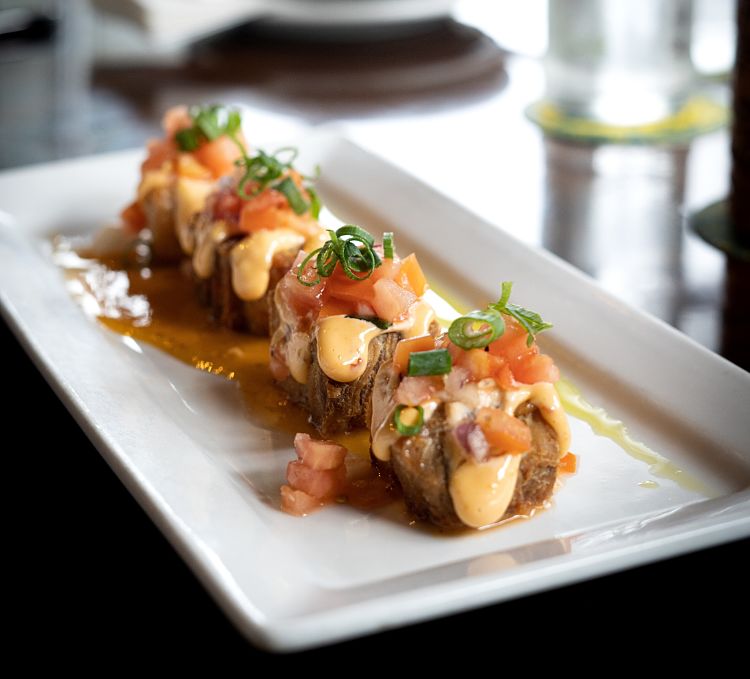
Filipino Barbecued Chicken Recipe with Inasal Dipping Sauce
Ingredients
For the chicken and marinade
- 15 g (1/2 oz) salt
- 8 cloves of garlic, peeled and minced
- 1 teaspoon of freshly ground black peppercorns 3g
- 100 ml (about 1/2 cup) Sprite soft drink or similar
- 60 ml (2 fl oz) annatto oil (see ingredients and method below)
- one medium size piece of fresh ginger, peeled and thinly sliced
- 80 ml (3 fl oz) Filipino cane or coconut vinegar, or apple cider vinegar
- 3 lemongrass sticks, bases and tough outer layers removed, roughly chopped
- 80 ml (3 fl oz) calamansi juice (see below), or 40 ml (1 1/2 fl oz) each of lemon and lime juice
- 1 whole free range chicken, spatch-cocked, with skin and fat removed and used for the annatto basting butter
For the inasal dipping sauce
- 1 clove garlic, minced
- 1 small shallot, finely diced
- 120 ml (4 fl oz) light soy sauce
- 1 bird’s eye chilli, finely chopped
- 30 ml (1 fl oz) calamansi juice (see below)
- 30 ml (1 fl oz) Filipino cane or coconut vinegar, or apple cider vinegar
For the annatto basting butter
- reserved chicken fat and skin
- 4 garlic cloves, peeled and minced
- 100 g (3.5 oz) salted butter, softened
- 30 ml (1 fl oz) calamansi juice (see below)
- 60 ml (2 fl oz) annatto oil (see ingredients and method below)
For the annatto oil
- 40 g (1.5 oz) annatto seeds
- 150 ml (5 fl oz) grape seed or rice bran oil (neutral flavoured vegetable oil)
Method
Make the annatto oil by adding the oil and annatto seeds to a small saucepan. Apply moderate heat and cook while stirring constantly until the oil takes on the colour of the seeds. Check the temperature with a thermometer if you have one. The ideal temperature is around 70 degrees C (150 degrees F). When very small bubbles appear when you stop stirring it is done. Remove the pan from the heat and allow to cool. Then, strain the liquid and discard the seeds. Set the oil aside to cool and use in the recipe.
Next, add all the marinade ingredients to a large bowl and mix well. Add the chicken, stir to cover all sides with the marinade. Then, cover the bowl with clingfilm and leave overnight in the fridge for the flavors to penetrate into the chicken.
Combine all of the ingredients for the dipping sauce and set aside. Make the basting butter by adding 60 ml (2 fl oz) of annatto oil to a small saucepan over low to moderate heat. Add the reserved chicken skin to the pan and fry slowly for around 15-25 minutes. Strain to remove the skin. Then, add the annatto/chicken oil to the rest of the basting ingredients and mix well.
The following day, remove the chicken from the marinade, drain and pat dry, Set the chicken aside, covered, so that it comes to room temperature. Then, make two cuts across the thickest part of each of the chicken legs right down to the bone. Grill the chicken on a charcoal barbecue or grill, skin side down first. Turn and baste the chicken regularly, being careful not to burn the chicken. The chicken should have a nice light orange-brown hue. The chicken is done when the thickest part of the thigh reaches about 73 degrees C (160 degrees F). Remove the chicken from the barbecue when cooked. Use a brush to baste all sides of the chicken and allow to rest for around 10 minutes before serving.
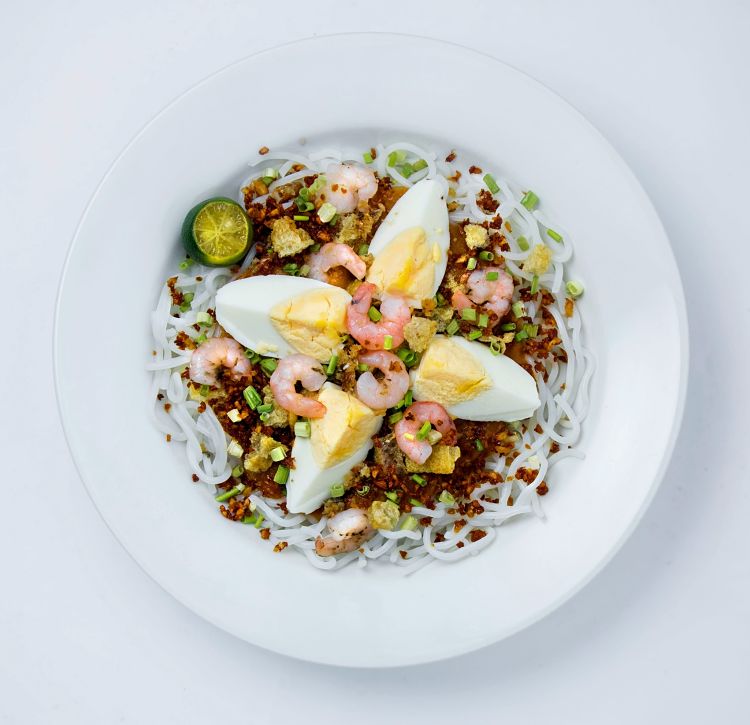
Kale Laing Recipe with Coconut milk, Ginger, Garlic and Chillies
Ingredients
- 1/2 teaspoon of salt
- 800 ml (3 1/3 cup) coconut milk
- 30 g (1/2 oz ginger), finely minced
- 30 g (1/2 oz) garlic, finely minced
- 2-3 bird’s eye chillies, finely minced
- 1 kg (2 lb) kale, thick stalks removed
- 80 ml (1/3 cup) grape seed or rice bran oil
- 1 teaspoon of freshly ground black peppered
- 50 g ( 2 oz) bagoong alamang (Filipino shrimp paste) or red miso paste
Method
Heat the oil over moderate heat in a Dutch oven or large heavy pan. Add the ginger, garlic and chilli, and stir-fry until light brown in color and softened, about 2-4 minutes. Add the bagoong or miso and fry while stirring constantly, for about 1-2 minutes. Add 1 cup of coconut milk and stir to deglaze the pan. Then, add the rest of the coconut milk and increasing the heat to high. Bringing the pan to a rolling boil. Add half the kale and mix gently until it starts to wilt. Then, add the rest of the kale, stirring the leaves through until the kale is coated in coconut milk. Lower the heat, and bring the pot to a gentle simmer. Cover the pan with a lid, or with foil leaving it slightly ajar. Cook slowly for about 60-90 minutes until the coconut milk has reduced, stirring now and then. Taste and season as needed with salt and pepper. Serve hot as a side dish, with jasmine rice and other dishes.
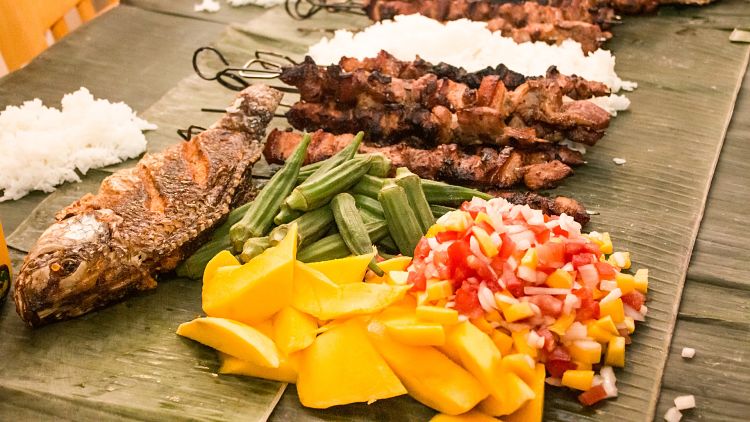
Filipino Mixed Vegetable Stew Recipe (Pinakbet)
Ingredients
- Salt to taste
- extra water if needed
- 1 large onion, chopped
- 80 g (3 oz) chicharones
- 2 large ripe tomatoes, quartered
- 100 g (3 oz) okra, stems removed
- 50 ml grape seed or rice bran oil
- 30 g (1/2 oz) ginger, finely minced
- 30 g (1/2 oz) garlic, finely minced
- Freshly ground black pepper to taste
- 100 g (3 oz) bitter melon, cut into half-moons
- 100 g (3 oz) snake beans or green beans, cut into short lengths
- 50 g (2 oz) bagoong alamang (Filipino shrimp paste) or red miso paste
- 250 g (8 oz) kabocha squash, sliced into medium size cubes (or butternut squash)
- 200 g (7 oz) Japanese or Thai aubergine, cut into 5cm pieces (or regular aubergines)
Method
Heat the oil over moderate heat in a Dutch oven or large heavy pan. Then, add the onion and stir-fry until transparent, about 3-4 minutes. Add the garlic and ginger, and fry for an extra 2-3 minutes. Add the tomatoes and cook, stirring often, until very soft (about 8-12 minutes). Add the bagoong and fry for 1-2 minutes, stirring continuously. Add the vegetables in batches, cooking and stirring for 3-4 minutes after each addition. Start with the squash, followed by the aubergine, okra, bitter melon and finally the beans. Then, cover the pot with a tight-fitting lid and cook for an extra 5-7 minutes or until all the vegetables are just tender. Add a little water is needed towards the end of the cooking. Season to taste with salt and pepper. Serve immediately in a large bowl, sprinkled with roughly crushed chicharones, fresh herbs and jasmine rice.
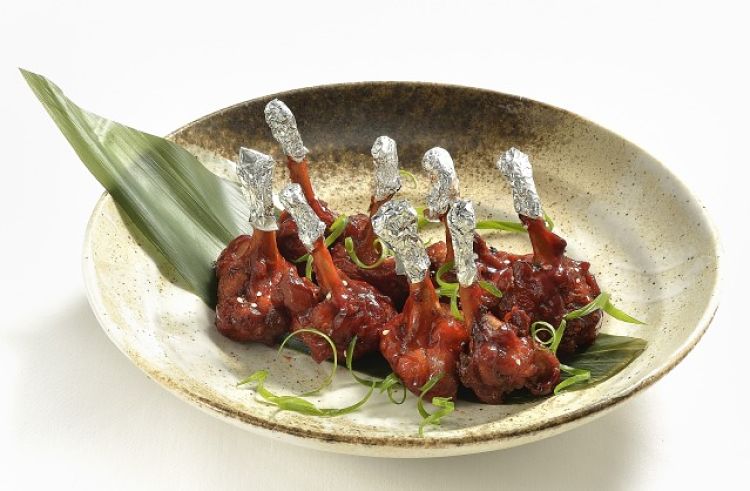
Filipino Pork and Chicken Adobo Recipe with Garlic Rice
Ingredients
For the Adobo
- 4 garlic cloves
- 150 ml (5 fl oz) soy sauce
- banana leaves, for serving
- 2 fresh or dried bay leaves
- 2 tablespoons of black peppercorns
- grape seed or rice bran oil, for frying
- 500 g (16 oz) chicken thighs, bones removed
- 200-300 ml (9 fl oz) Filipino coconut vinegar, or equivalent
- 500 g (16 oz) skinless, boneless pork belly, cut into bite-size pieces
For the garlic fried rice
- salt, to taste
- pinch chicken powder
- 2 large garlic cloves, finely chopped
- 500 g (16 oz) cold cooked jasmine rice
For serving
- red chilli slices
- Fresh herbs, chopped
- 1 fried egg per person
Method
Make the adobo by grinding the black peppercorns in a mortar and pestle. Add the crushed garlic and grind together with the peppercorns, and then set aside. Next, add 1-2 tablespoons of oil in a Dutch oven or large, heavy and deep frying pan and heat using a moderate to high heat setting. Then, transfer the pork to the pan and stir-fry for 1-3 minutes. Next, add the chicken in batches and fry for 3-6 minutes on each side or until it begins to caramelise. Brown the meat in batches to prevent crowding in the pan. Transfer the cooked meat to a bowl as you go.
Clean the pan and add some more oil. Add the bay leaves, crushed garlic, and pinch of salt and freshly ground pepper and fry over moderate heat for 60-90 seconds or until fragrant. Return the meat to the pan. Pour in the soy sauce and vinegar and simmer for several minutes. Then add about half a cup of water. Cover the pan with a lid, reduce the heat to low and simmer for 45 minutes stirring occasionally.
Meanwhile, prepare the garlic fried rice by firstly heating a large frying pan or wok over moderate heat. Add a little oil and fry the garlic until just starting to become golden. Add the rice and mix well to combine, breaking-up any large clumps. Add the chicken powder, season to taste with salt and stir while frying until the rice is hot. Serve the chicken and pork adobo on a platter lined with banana leaf and topped with a sprinkle of fresh herbs. Serve the garlic fried rice on the side, topped with a fried egg for each person.
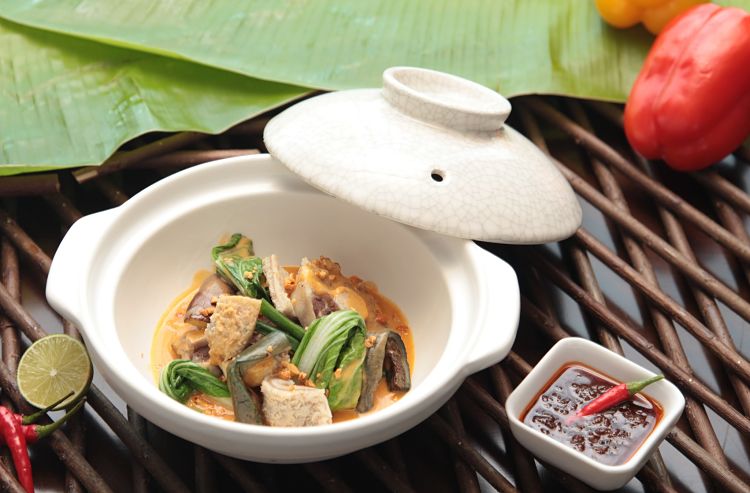
Filipino Sweet and Sour Fish Recipe
Ingredients
- 2 tablespoons vinegar
- 2 garlic cloves, diced
- 1 cup chopped pineapple
- 2 tablespoons cold water
- 2 tablespoons tomato sauce
- 1 small brown onion, diced
- 2 tablespoons sweet chilli sauce
- 1 teaspoon of cornstarch, to thicken
- 2 teaspoons of fresh chilli, to garnish
- 1 litre ( 1 quart) rice bran or grape seed oil
- 2 teaspoons of coriander or other fresh herbs, to garnish
- 1 medium-size firm, white fleshed fish such as grouper or bream, cleaned and filleted
Method
Heat the oil in a large saucepan or Dutch oven over moderate heat until it reaches 190 degrees C (375 degrees F) using a frying thermometer. Make 3 diagonal slits into each of the fish fillets. Fry the fish in the oil for 3-5 minutes, or until crisp and golden. Carefully transfer the fillets onto a paper towel to drain. Next, make the sauce mixture by combining the sweet chilli sauce, vinegar, tomato sauce, a pinch of salt, the cornstarch and 2 tablespoons cold water in a mixing bowl. Whisk thoroughly to a smooth consistency and then set aside.
Next heat 1 tablespoon of cooking oil in a heavy frying pan and cook the onions and garlic for 1–2 minutes, or until just starting to brown a little. Add the sauce mixture to the cooked garlic and onion, and then stir through the pineapple pieces and cook for another minute or two. Place the fish in the centre of a suitable serving dish. Drizzle the sauce over the fish and along both sides of the plate. Serve warm or hot, garnished with chopped fresh coriander, diced fresh chilli and other herbs.
Filipino Chicken Noodle Soup (Sotanghon) with Fresh Homemade Chicken Stock
Ingredients
- 1/3 cup fish sauce
- 150 g bean thread vermicelli
- 1 large onion, thinly sliced
- 4 cloves of garlic, finely chopped
- 500 g ( 1 lb) wombok, thinly sliced
- 4 hard boiled eggs, peeled and halved
- 1.5 kg (3 lb) whole chicken or chickens
- 1 teaspoon annatto powder (or equivalent)
- Medium size piece of ginger, finely chopped
- 2 1/2 tablespoons rice bran or grape seed oil
- 8 cups freshly made chicken stock (this is vital)
- 1 large carrot, peeled and cut into fine matchsticks
- 1 bunch of Chinese celery or green onions, trimmed and sliced
- Fried garlic slices, hot red chilli slices and fresh herbs, to serve
Method
Place the whole chicken, or chicken into a large heavy saucepan or Dutch oven. Add the stock and enough extra water to just cover the chicken. Bring the pan to a simmer over moderate-high heat, and then reduce the heat to a simmer and cover the pan. Cook the chicken for 50-65 minutes or until the chicken is just cooked. Then, use tongs to lift out the chicken and place it on a plate. Reserve the liquid for use later. Cool the chicken and when cool enough, take off the meat, discarding the skin and bones. Shred the chicken meat coarsely with a fork and your fingers and set aside. Next, place the noodles in a bowl, cover with cold water and soak for 15-18 minutes or until softened. Drain the noodles well and set aside.
Next heat the oil in the large saucepan or Dutch oven saucepan you used previously over moderate heat. Add the garlic, onion and ginger and stir-fry over moderate heat for 3-4 minutes or until the onion has just softened. Add the carrot and Chinese celery and stir-fry for another 5 minutes or until the vegetables have softened. Add the Chinese cabbage and the annatto powder stir-fry cook for an additional 4-5 minutes or until cabbage has wilted.
Next, skim any fat from the reserved chicken cooking liquid and then pour it into a saucepan with the fish sauce. Bring the mixture to a simmer. Add the noodles and cook for 6-8 minutes or until the noodles are transparent. Then, add the chicken pieces. Cook for another 3 minutes or until the chicken is heated through. Divide into serving bowls, topping each with 2 egg halves, a sprinkle of fried garlic and fresh herbs. Serve hot.
Filipino Barbecued Chicken Recipe with Annatto Oil Basting Sauce (inasal)
Ingredients
6 chicken leg quarters
For the Annatto oil
- 1 bay leaf
- 5 garlic cloves, crushed
- 50 g ( 1.25 oz) annatto (atchuete) seeds
- 150 ml (5 fl oz) rice bran or grape seed oil
For the Marinade sauce
- 2 tablespoons sugar
- 1 1/2 tablespoons salt
- 5 cloves garlic, crushed
- 1 1/2 tablespoons pepper
- 3 lemongrass stems, crushed
- 90 ml (3 fl oz) annatto oil
- 2 teaspoons fresh ginger, grated
- 50 ml (1.75 fl oz) sugarcane vinegar
- 90 ml (3 fl oz) calamansi or lime juice
Method
Note: You need to begin this recipe 1 day in advance to allow the chicken to marinade properly.
Prepare the annatto oil by heating the grape seed or rice bran oil in a heavy saucepan over moderate heat. When hot add the garlic, annatto seeds and bay leaf. Once it starts to bubble, turn off the heat. Set the oil aside for 2 hours and cool down. Store in a sealed container in the refrigerator. Next, combine all the marinade ingredients together. Stir to mix thoroughly and set aside. Slice the chicken into square pieces about 5 x 5 cm (2 x 2 inches) in size. Mix the chicken pieces with half the marinade, ensuring all the surfaces and sides are covered with the marinade. Transfer to a storage container with a lid or large zip-lock bag. Mix well, cover the container or seal the bag and marinate for at least 12 hours in the refrigerator.
Place the remaining marinade mixture into a small saucepan and simmer for 2 minutes. Remove from the heat and set aside to use as the basting sauce. On the next day, take the marinated chicken out of the refrigerator and thread 3-4 pieces of chicken onto each skewer. Cook over a grill or a charcoal barbecue, regularly basting with the remaining marinade. Baste completely once again just before serving hot.
Filipino Roasted Pork Belly with Pickled Green Mango
Ingredients
- 1/4 cup fine sea salt
- 1 bunch spring onions
- olive oil, for drizzling
- 2 long red chillies, roughly chopped
- 1.5 kg (3 lb) boneless pork belly, skin on
- 1 garlic bulb, peeled, cloves roughly chopped
- 1 pineapple, peeled, cut into medium thick rounds
- 2 lemongrass stalks, white part only, roughly chopped
For the Pickled green mango
- 1/4 cup fine sea salt
- 1 1/2 cups caster sugar
- 1/2 cup coconut or rice vinegar
- 1/4 cup mild-flavoured beer, such as ale
- 3 green mangoes, peeled, cut into 1 cm (1/3 inch) wide strips
Method
Make the pickled green mango by adding the vinegar and salt to a large bowl and stirring until all the salt dissolves. Then, add the green mango. Cover the bowl with plastic wrap and refrigerate overnight. Next use a mortar and pestle to grind the lemongrass, garlic, chilli, and 1/4 teaspoon of salt to a paste. Season with freshly ground pepper and a little more salt if needed.
Use a small very sharp knife to score the pork skin cross-ways with cuts about 1.5 cm (1/2 inch) apart. Turn the pork over so that the pork skin-side is down and rub the garlic mixture into the pork meat. Flip the pork piece over and rub sea salt all over skin. Place the pork in a large baking dish and set aside in the refrigerator, uncovered, overnight to dry the skin out and allow the rub to penetrate.
Continue making the pickled green mango by adding the sugar and 1 1/2 cups of water to a saucepan. Bring to the boil over moderate–high heat, stirring regularly until all the sugar is dissolved. Then remove the pan from the heat. Transfer the mango to a large sterilised jar. Then, pour the sugar syrup and beer into the jar. Refrigerate until you need it. The pickled green mango will keep in fridge for 2-3 weeks.
Next, preheat your oven to 160 degrees C (320 degrees F). Remove the pork from the refrigerator and set it aside to come to room temperature. Add the pineapple and spring onions to large roasting pan, spreading over the base. Then, place pork belly, skin-side up, on top of the pineapple and spring onions. Drizzle with olive oil, rubbing a little into the skin and sides of the pork. Then, roast the pork for 1 1/2 hours at 160 degrees C (320 degrees F). Then, increase the oven temperature to 200 degrees C (390 degrees F) and roast for an additional 30 minutes, or until skin is blistered and crisp. Remove the pork from pan and set aside to rest uncovered for 15-20 minutes. Serve with the pickled green mango and the juices from the baking pan.